
4.9★ on G2 reviews

4.7★ on Capterra reviews
Explore fresh, expert perspectives on customer engagement and innovation
Stay at the forefront of customer engagement, contact centre innovation, and AI-powered communication.
discover the latest
articles and insights
It sometimes feels like we live in an angry age. It certainly feels that way to customer-facing staff, who have been subject to a growing torrent of abuse since the start of the pandemic.
In fact, according to the Institute of Customer Service, 60% of customer-facing staff have experienced hostility from customers since early 2020, ranging from shouting and swearing to racial abuse, death threats, spitting and physical attacks. The Institute is running a campaign to highlight the issue.
But it’s not just abuse. Contact centre staff in many sectors are also fielding a growing number of calls from distressed customers who may be struggling to pay bills or meet other commitments.
Research from Forrester in 2021 found that nearly 67% of contact centres were dealing with more complex customer enquiries than a year earlier, and that 70% were facing more calls from “emotionally charged” customers.
Much of this research was carried out during the heat of the pandemic, but with the cost of living crisis in full swing, the situation is unlikely to ease.
With that in mind, we’ve put together six tips to help contact centre staff deal with angry or emotional customers.
6 ways to deal with difficult customers:
1) Have clear processes in place
In most cases, angry customers can be calmed by an advisor who takes their issue seriously and, if the matter can’t be dealt with there and then, describes a clear path to resolution.
Have guidelines in place for every eventuality and a consistent series of next steps. Make sure your team know them (intelligent scripting can help) and can talk them through with customers. Customers often get frustrated when they can’t see an end to the issue or worry they’ll spend long periods of time in call queues or being passed between departments.
When advisors take ownership of their issue, many customers quickly become calmer.
2) Give customers obvious ways to complain
It sounds counterintuitive, but making it easy for customers to complain is one way to keep them happy.
Most customers accept that mistakes sometimes happen. Frustrations arise when there’s no obvious way to draw an organisation’s attention to an error or oversight. Advertise a complaints line and email, and ensure they’re monitored. Customers will appreciate easy ways to report issues, as long as organisations respond promptly and appropriately.
3) Remain calm and constructive
However irate a customer gets, team members should stay calm, focusing on what they can do to help. It’s easy to get infuriated with customers who appear to be taking their own frustrations out on a blameless employee, but it’s also counterproductive. It will probably prolong the call, inflame emotions further and could lead to unnecessary escalation. Unless the customer becomes abusive, stay personable, and emphasise the steps you are taking – or will take – to resolve the problem. Empathy is crucial here. If the organisation is in error, agents should acknowledge that the customer has a right to be unhappy.
At the same time, advisors shouldn’t have to suffer insults and abuse. Have guidelines in place for them to follow in the event that an emotional caller becomes an insulting or threatening one. For example, some contact centres transfer rude and abusive customers to a recorded message.
4) Differentiate between angry customers and abusive ones
We should also reiterate again that customers have a right to complain about poor service or an error that costs them time and energy to resolve. An angry customer venting about the faulty processes of the organisation is not the same as an abusive one directing anger at an individual agent. Organisations should be able to accept honest criticism and act on it.
5) Offer callbacks
If a team member can’t resolve an issue during a call, the next best way to diffuse a difficult situation is to offer a callback. Advisors may need to involve another department in a customer complaint, or escalate it to a senior manager. Putting a customer on hold during this process can lead to growing frustration, especially if the wait is longer than a couple of minutes. Offer a callback so the customer can get on with their day while their complaint is dealt with. But if you do offer a callback you have to honour it, and at the time agreed.
6) Train your advisors
It’s a good idea to train your team to deal specifically with difficult calls, but training more generally is even more essential. In a nutshell, the more knowledgeable your team is, the more faith customers will have that they can and will resolve complex issues.
In fact, the kind of good contact centre management practices that help drive efficiency can also help to reduce the number of difficult calls agents have to deal with. For example, fast call answering can take the edge off a customer’s anger. Answering an email complaint within the advertised time shows you take complaints seriously. Intelligent call routing that gets them to the right person first time cuts out one cause of customer frustration.
In other words, having the tools in place to manage your contact centre effectively also helps to pacify difficult customers. Those tools should include intelligent scripting. Giving agents scripted guidance helps them lead difficult conversations to a satisfactory outcome. Download our ebook for more information on smart scripting and templates you can use in your own contact centres for dealing with difficult customers.

5 Must-Have Dialler Features You Need In Your Outbound Call Centre
Whether you’re looking to supercharge sales, streamline debt collection, or elevate customer service, the right outbound dialler can redefine how you connect and communicate. So, continue reading to learn more about automated diallers and discover the potential they hold for your contact centre’s success
So, what’s an outbound dialler?
Put simply, outbound dialling is the process of making calls to customers or contacts, typically for sales or marketing purposes.
While outbound dialling can be performed manually on a mobile or business phone, this is not practical when dealing with a high volume of calls. A range of additional features can enhance outbound calling in a contact centre setting through the use of an automated dialler.
What does an outbound dialler do?
An outbound dialler is generally a cloud or software solution that automatically dials phone numbers and makes calls on behalf of your sales, collection or customer service teams. As such, it’s an essential ingredient in any organisation where you need to make outbound calls to clients and prospects throughout the day.
What are the different types of call centre diallers?
The main options are a manual dialler and an auto dialler.
Manual Dialler
A manual dialler is like a traditional phone. A call agent manually dials numbers from a call list, one after another.
Auto Dialler
As the name suggests, an auto dialler automates much of the dialling process. It digitally dials numbers, and can also dial multiple numbers at once, passing answered calls to available agents.
Manual vs Auto Dialler
Why would you choose one over another? Most call centres now opt for auto dialling, because it significantly boosts productivity. Agents spend more time talking to customers and less time dialling unresponsive numbers.
Manual dialling can still be useful, but only for campaigns involving a small number of high value customers who demand a more personal approach.
The different outbound dialler modes
If you’re using an auto-dialler, there are likely three dialler modes that you’ll frequently use, depending on the type of outbound calling you are doing. These are predictive diallers, progressive diallers and preview diallers.
Predictive dialling
What is it? When most people think of outbound dialling software, they tend to think of predictive dialling. Predictive dialling places calls based on the software’s predictions of agent availability. It dials multiple numbers simultaneously, so that when agents finish one call they can be instantly connected to the next.
What are the benefits? The best predictive diallers minimise abandoned calls (and the amount of time customers spend on hold) and maximise the time your agents spend having conversations. When should I use it? Predictive dialling is the standard for straightforward, high volume sales campaigns (like commodity sales) or debt collection activity.
Progressive dialler
What is it? Progressive diallers are predictive diallers that slow the pace down by only dialling a number when an agent is available to take the call. Dialling is instant and automatic, so the system still allows for a relatively high number of calls.
What are the benefits? Progressive dialling eliminates the risk of customers abandoning calls or waiting a frustratingly long time before being connected to an agent. Because an agent is always available, the customers you have painstakingly nurtured over a period of time feel valued and importan
When should I use it? It is often used in campaigns that target current customers. It’s a low risk option that can improve customer experience and effectively help agents upsell additional products and services.
Preview dialler
What is it? A preview dialler takes the pace down another notch. When an agent indicates availability, information about the next call is sent to the agent for preview.
After a set amount of time – say, one minute – the number is automatically dialled. This delay lets the agent prepare for the call, using information typically taken from the company CRM system – which are often integrated into the dialler.
What are the benefits? Agents can have more in-depth, focused conversations, based on a customer’s real experiences and challenges. It can improve customer experience and increase the number of positive outcomes.
When should I use it? Preview diallers are particularly helpful when the reason for the call is complex or sensitive. For example, following up with web leads or dealing with customer complaint calls.
Explore the three dialler modes in more detail >
How are automated diallers used?
Outbound diallers can be integrated into many industries. Any company with an outbound contact centre who are cold calling or making high volume phone calls can benefit from outbound dialler software.
Power up your sales teams
Sales campaigns are often high volume and low touch. Predictive dialling is the gold standard for straightforward, high volume outbound campaigns (like commodity sales). It can quickly and efficiently work through large datasets, making sure leads are contacted while they’re still warm.
The best predictive diallers minimise abandoned calls (and the amount of time customers spend on hold) and maximise the time your agents spend having conversations. They can be set to play messages if they meet an answerphone, and will recycle numbers (placing unanswered calls back into the call queue) in a way that ensures your customers or leads are contacted, but never pestered.
The right outbound dialler can make selling straightforward by helping to connect your sales people to the right customers at the right time. Combined with the contact centre-specific features mentioned earlier, it can offer powerful tools for contacting customers, winning business and exceeding customer expectations.
Increase debt collection rates
Your credit and debt resolution teams can use effective targeting to reach priority customers at times that suit them. Maximise collection rates using advanced data segmentation and encourage self-serve with automated communications. Automate payments with self-serve options providing customers choice and improving satisfaction.
Preview diallers are particularly helpful when the reason for the call is complex or sensitive. For example, debt collection calls are more likely to end positively if agents have the time to gather all the information they need beforehand.
Elevate your customer service teams
Customer service teams often use progressive dialling to target current customers with after sales information or courtesy communications. It’s a low risk option that can improve customer experience, help nurture loyalty and effectively help agents upsell additional products and services. Because an agent is always available to have a conversation, the customers you have painstakingly nurtured over a period of time feel valued.
5 must-have outbound dialler features
Answer Machine Detection (AMD)
Answer Machine Detection (AMD) lets your auto-dialler software identify answering machines before connecting calls to agents. This means agents only spend time on live conversations, saving them valuable time and boosting productivity.
AMD is particularly helpful for high-volume sales campaigns where every minute counts. MaxContact’s AMD boasts a 90% success rate in detecting answering machines, freeing up agents to focus on reaching real people.
Speech analytics
Forget manually reviewing call recordings! Speech analytics uses AI to analyse every conversation, automatically identifying customer sentiment, call quality, and agent performance. This lets you:
- Spot frustrated or vulnerable customers who need extra care.
- Ensure agents follow compliance guidelines.
- Understand what customers are saying about your products and competitors.
Speech analytics gives you valuable insights from all calls, not just a select few. It saves time and helps you improve the overall performance of your contact centre.
A secure payment manager
A secure payment IVR gives customers the payment options they want, while giving teams the time they need to deal with more complex or sensitive cases.
Payment automation helps you speed up debt collection and improve cash flow. When you give customers more convenient ways to pay, they’re more likely to stick to payment schedules.
MaxContact’s payment IVR is fully PCI compliant, protecting customer information at all times. We offer both assisted payments, in which staff safely guide customers through the payment process, and automated payments, which are fully self-serve and available 24/7.
Analytics and reporting
You can only improve contact centre performance when you can measure it. When you’ve done that, you need to present the data in a way that is easy to understand and act on. That’s where analytics and reporting come in.
MaxContact’s pre-configured reporting gives you complete visibility around productivity, issue resolution rates, revenue and customer satisfaction, to name just a few. You can set targets for campaigns, channels, teams and agents and track performance over time.
All teams – sales, service and debt resolution – benefit from better information. Pre-configured reports give you the data you need in the quickest and most hassle-free way.
Easy integration
A powerful dialler is even better when it works hand in hand with your existing systems. Imagine a sales agent having instant access to customer history, preferred contact methods, and past feedback – all within the dialler interface (thanks to CRM integration).
This allows for personalised conversations that address specific needs, leading to happier customers and improved outcomes. Easy integration applies to after-sales and debt resolution teams too. By connecting your dialler with other systems, you can put all relevant information at agents’ fingertips, reducing hold times and boosting overall efficiency.
The benefits of auto-dialler software you can’t ignore
Improve contact centre metrics like AHT
Average Handling Time (AHT) is a calculation based on the time agents spend talking to a customer, the amount of time callers are on hold and the time taken on follow up tasks, divided by the number of calls handled. The lower your AHT, the better. It means you can handle more calls, improve efficiency and reduce costs. A good dialler can improve AHT and a host of other contact centre metrics, by allowing agents to handle more calls, more efficiently.
Excel at sales and debt collection
Whether it’s sales or debt collection, the best results happen when good agents talk to customers. Whether it’s a high volume, low touch sales campaign, or more sensitive debt resolution calls, the right dialler means your agents spend more time in conversation with customers, and less time processing unanswered calls or connecting to answering machines.
Keep your contact centre compliant
A powerful predictive dialling algorithm speeds up and slows down depending on the conditions in your contact centre. If fewer agents are available, the dialling slows down, helping to ensure you stay within compliant boundaries for abandoned and dropped calls. Or you can switch to progressive or preview modes for more personal contacts. The dialler can also ensure that the frequency of calls to a contact never exceeds official limits.
Seamlessly integrate with your CMS
A dialler that integrates with your CMS system is a huge advantage. It means that the systems feed information to each other, so your agents always have the details of previous contacts at their fingertips. That reduces the risk of customers becoming annoyed by having to repeat information they’ve already previously given. It can also provide insights into customer satisfaction rates, preferred times and methods of communication and so on.
These companies boosted performance with auto diallers
We worked with these companies to replace ageing systems with modern cloud-based diallers – and the results are impressive.
Compare My Insurance
Compare My Insurance is one of the largest independent insurance and protection specialists in the UK. But dialler downtime, data issues and missed opportunities were hampering the business.
MaxContact’s dialler solution integrated seamlessly with the company back office systems. It has significantly increased contact rates while providing complete transparency around performance and progress.
APJ Solicitors
APJ Solicitors, a leading financial mis-selling specialist, needed to increase call volumes and boost efficiency, but its basic VOIP phone system was no longer up to the task.
MaxContact’s solution increased call volumes by 110% in the first year, and improved average agent call efficiency by 36%. Productivity has risen five fold over the company’s previous solution.
Improve your call centre performance with MaxContact
MaxContact offers the most sophisticated outbound dialler currently available. This continually improving cloud-based dialling solution gives you the flexibility to run your contact centre your way, letting you choose the right blend of productivity and compliance for your business needs. With over a 1,000 unique features, MaxContact’s outbound dialler helps meet your contact centre challenges in new and powerful ways.
Learn about how MaxContact’s auto dialler can improve your contact centre operations. Book a demo today to find out more.

Poor mental health costs UK contact centres almost £1 billion each year
Those working in contact centre roles say that work-related poor mental wellbeing is making them less productive, including answering fewer calls and taking more sick days – costing the industry over £990m in lost productivity every year. That’s according to our new study, Duty of Care Gap.
The contact centre industry is a huge contributor to the UK economy, employing over 800,000 people across the country. Yet the industry is facing a mental health crisis, with 83% workers saying their work is taking a toll on their mental wellbeing, with staff reporting high stress levels (62%), anxiety (48%) and feeling overwhelmed (46%).
This poor mental wellbeing at work is costing the industry millions in lost productivity at a time when staff attrition is already high. An overwhelming majority (95%) say that work-related mental wellbeing problems are making them less productive at work, losing on average six hours of work per month, or nine working days per year to poor mental wellbeing. This is also translating into sick days – staff report taking on average 2.78 sick days due to work-related mental wellbeing problems. This lost productivity is costing the industry £990milllion per year.
Encouragingly, the research also reveals many businesses are already taking steps to help. Over half (52%) have mental health first aiders in place, but this is in stark contrast to physical health and safety, where each workplace is legally obliged to have nominated first aiders and carry out regular risk assessments.
For businesses that do prioritise the mental health of contact centre workers, the benefits are clear. The overwhelming majority (75%) of contact centre workers say they would be more likely to say in their current role if their employer made a bigger concrete commitment to improving mental wellbeing in their workplaces. Also, 46% say they would consider another role in the contact centre industry if it would be better for their mental health.
To help those using their technology, MaxContact has launched a new Employee Wellbeing feature which provides helpful, unobtrusive tips throughout the day to help staff take steps to improve their physical and mental wellbeing while at work. The reminders focus on three key areas: body position, hydration and positive mindfulness. Contact centre leaders can monitor anonymous, aggregated data on these actions to track how their staff are feeling and offer more support if needed.
Ben Booth, CEO at MaxContact, says, “Contact centre workers work unbelievably hard behind the scenes to make sure our society works. We’ve worked with contact centre leaders to understand the challenges the industry faces. What we’ve discovered shows just how difficult the job is. What’s more, the problem is only getting worse as the cost-of-living crisis gets even more serious and contact centre workers are the ones who have to deal with the angry or upsetting calls about rising costs.
“We’re calling for businesses that employ contact centre workers to make mental wellbeing just as important as physical health and safety, with properly trained mental health first aiders in every organisation. It’s not just the right thing to do, it makes total business sense.
“We know we have a part to play too in making the industry better. That’s why we’ve launched our Employee Wellbeing feature as part of our making 2022 the year of the agent, focusing on both physical and mental wellbeing. It’s not an answer to the problem but it’s a step in the right direction and we’ll keep on looking for ways to put workers at the heart of our platform.”
Dr Andres Fonseca, Consultant Psychiatrist and Co-Founder at leading mental health care organisation Thrive: Mental Wellbeing, threw his support behind the findings, saying, “Employee mental health can seem like a difficult topic to navigate but creating an environment that supports and educates staff has many advantages. It is vital that we equip all employees, but especially those in such frontline roles, with the necessary tools and techniques to effectively manage challenging conversations. With more focus on the cost of living crisis, it is also imperative that we continue to open up the conversation around mental health and raise more awareness of the connection between physical and mental wellbeing while ensuring that everyone across the workplace knows that they are valued and supported.”
Read the full Duty of Care Gap report, here.
As the cost of living crisis continues and bills continue to soar, contact centres are facing an increase in vulnerable customers who are seeking support. Now more than ever, it’s crucial that these customers are able to easily receive the correct support and that contact centre teams are prepared for potentially difficult and distressing conversations.
Accessing adequate customer service is vital, especially during the cost of living crisis.
Being on the frontline of organisations, contact centre advisors see and hear the impact this is having on customers first. It’s important that agents have the right tools in place to effectively support vulnerable customers during these tough times without jeopardising their own wellbeing.
Identifying vulnerable customers
The FCA recently widened its definition of a vulnerable customer. While it includes more commonly known groups, such as the elderly and those with certain health conditions. It now also includes individuals that are sometimes more difficult to identify, like people with addictions, those who need care from others and those with low financial resilience.
That’s particularly important when you consider that, as the FCA survey shows, many more people have found themselves financially vulnerable, with a 15% rise in people feeling financially vulnerable since the start of the pandemic.
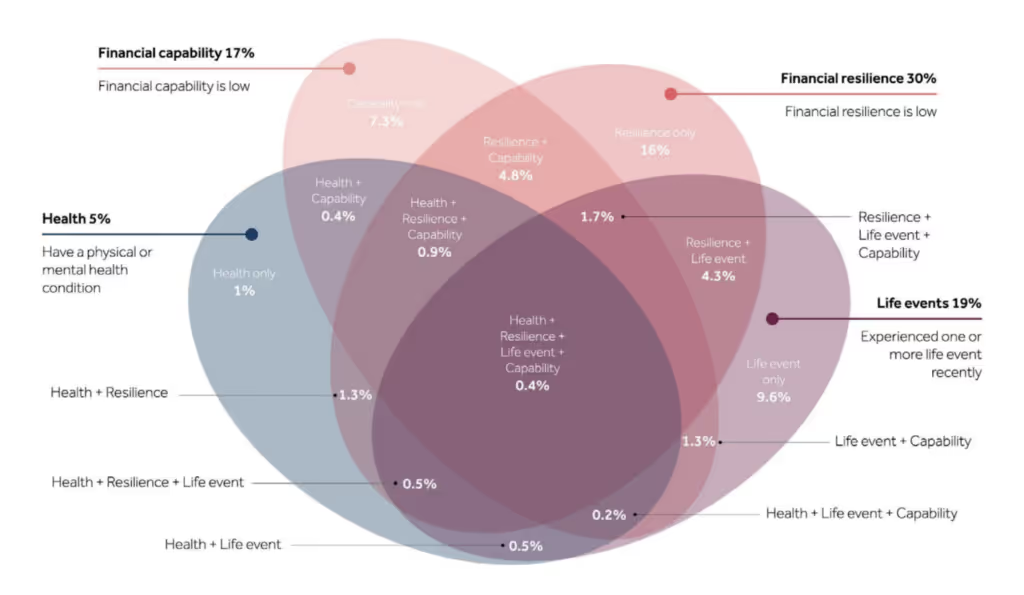
At the same time, the increase in the number of vulnerable people creates additional workload for companies that have a duty to identify them in their own customer base and during any sales process.
That’s important for businesses to know, but the fact is that it’s not always easy to identify vulnerable people from basic information provided on a form, or even during a phone call.
Despite recent progress, customers can sometimes still feel stigma around mental health, poverty and poor literacy levels. In fact, customers may be reluctant to bring up a host of issues that would identify them as vulnerable to your agents.
[Watch] How to identify and best serve your vulnerable customers in your contact centre >
Insights from our research
We recently worked on a comprehensive piece of research where we surveyed 1000 vulnerable UK people who’d had recent interactions with customer service support.
At a glance, we found that:
- 45% have struggled to get through to the right person or department when contacting customer service.
- 51% have been passed between different agents and had to re-explain their problem several times.
- 30% of respondents said that their finances were negatively impacted by the inability to contact a company’s customer service.
- 27% feel their needs are not being accommodated by customer service staff.
- 30% feel as though advisors are trying to get them off the phone quickly.
5 ways you can help vulnerable customers achieve good outcomes
In this guide, we share five practical ways your contact centre can support vulnerable customers during the cost of living crisis and beyond.
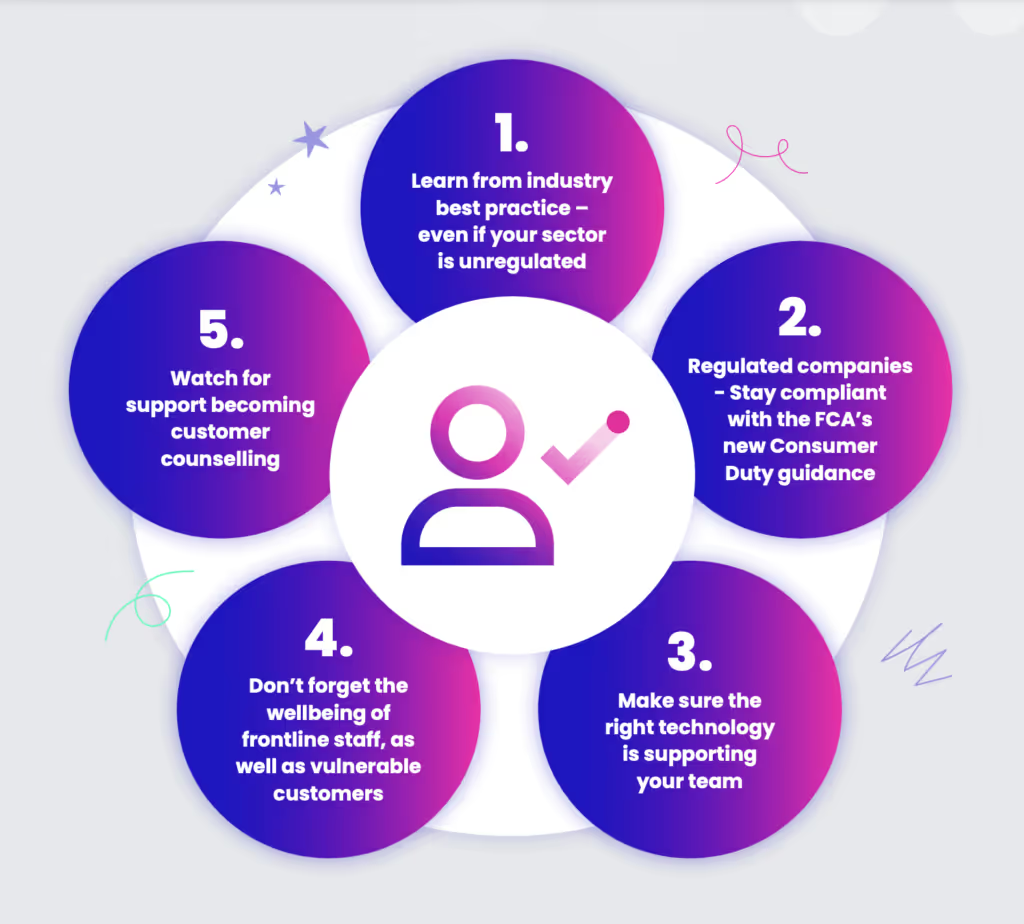
1. Learn from best practice – even if your sector is unregulated
As customer concerns rise, even those in unregulated sectors could face an influx of more challenging calls so it’s important that all businesses are prepared and know the best practices in order to support vulnerable customers through the tough times ahead.
Can you easily scale your support for vulnerable customers?
- There are currently 27.7 million vulnerable customers in the UK but this number is set to grow. Greater support will be needed from firms as the number of customers facing hardship rises.
- If all staff aren’t trained to deal with vulnerable customers, make sure they are able to spot signs that a customer is struggling and know the appropriate colleagues to pass them on to for support.
- Consider training wider agent teams so they can handle vulnerable customers and ensure teams have support when things get really busy, including breaks from emotionally intense work.
Utilise scripting – but cut canned responses
- Consider holding back from sending canned responses for these customers as they can easily be misconstrued and seem uncaring. Personalised responses are more appropriate for vulnerable customers as they may need more detail or clarity on discussion points.
- Instead, having a scripting guide for teams to follow gives them confidence and makes sure they are prepared for any jarring questions. It also makes sure customers feel valued and reassured that the company is doing the right thing
Check out our guide to writing effective scripts >
Always follow up on what is discussed with the customer
- For example, share affordability statements and plans via links in email or SMS and emphasise the purpose of this communication is to make sure that you come to a solution that is right for both the business and customer and to eliminate any repeat conversations in the future.
- This empowers the customer to feel they understand what is being asked of them and why and encourages an honest response.
2. Stay compliant with the FCA’s new Consumer Duty guidance
The current economic climate means that it’s crucial that customers are able to make good financial decisions. Our research shows that current customer service needs to improve to ensure vulnerable customers feel supported; 27% feel their needs are not being accommodated by customer service staff.
The FCA’s new Consumer Duty guidance will not only set higher and clearer standards of consumer protection across financial services, but it will also require firms to put their customers’ needs first and provide clear communication and support.
Are your team trained to spot those in financial difficulty?
- Due to the cost of living crisis, this group will become much larger – putting even more pressure on teams.
- Make sure teams aren’t just dealing with the request in front of them but are also thinking about the customer as a whole. For example, forecasting cash flow issues to ensure someone can pay for something in future and working that into customer support conversations.
Are customers having to repeat themselves?
- It can be difficult for customers to open up to an agent, so being transferred and repeating themselves to multiple agents can stress out vulnerable customers.
- Make sure call information is captured in one system so different departments and agents have one version of truth.
Is your customer support proactive?
- Instead of waiting for customers to come to you, proactively contact customers who may be dissatisfied or having problems.
- Unexpectedly calling or messaging shows customers you are honest and upfront, reassuring them that something is being done and you care.
- For example, check in with customers before their next bill even if it’s just a WhatsApp, email or text message to inform them the next payment is coming up and ask if everything is ok, if they can meet this payment or if they need to have a conversation around payment – this is helpful support for people who have habitual struggles with payment.
3. Get the right tech in place
Leveraging technology allows agents to spot trends in customer conversations and enhances training and coaching, allowing staff to make more informed decisions when supporting customers.
Have you got interactive scripting guides for teams to follow?
- Having scripts and guides within your software can help agents to lead the conversation, but it’s important it doesn’t become a “one size fits all” templated response. Include information on where agents can point customers to if escalation is needed e.g. relevant charity support.
- Let agents know the areas where they can / can’t help, and where their role ends.
Do you offer the right communication channels?
- Different customers have different needs and preferences – offer phone, text, email, webchat.
- Phone lines are still vital – 50% of those aged 75+ have no online access.
- People might also find it easier to open up on webchat/SMS as they can share their difficulties without feeling as if they’re being judged. However, you miss verbal cues and tone – so teams need to be careful in how they respond and make sure this is interpreted correctly.
- Being able to write down thoughts in an email can also allow customers to methodically structure what they want to say and gives agents time to read and digest the information, as well as keep some emotional distance.
- Even if conversations start in text form, it’s important to try to get that person onto a phone call as quickly as possible where nuance and tone can be captured.
Do you have speech analytics in place?
- A modern speech analytics platform doesn’t just capture the words spoken, it can capture HOW they are spoken. For example, highlighting uncertainty in a customer response.
- The software automatically identifies these potentially vulnerable customers so that the business can track them and take further action if necessary.
Discover how speech analytics can turn conversation into insights here >
4. Support front-line staff who are dealing with calls
Nearly three-quarters (72%) customer-facing staff say they’re burnt out or facing burnout due to increased workload. And for those speaking to vulnerable customers this pressure is even greater – which is why supporting staff is key to supporting vulnerable customers.
Image stat, text: 72% of customer-facing staff say they’re burnt out or facing burnout
Can you instantly access call recordings?
- If an agent has a difficult call, team leaders should be able to instantly access call recordings to make sure they have all the information they need to empathise and support agents when they ask for support.
- But it’s not just calls. Live monitoring of conversations across SMS, web chat and email allows leaders to provide actionable feedback and coaching to teams and individuals.
Do you have peer support groups?
- Give agents self-learning time where they can gather to vent and discuss how to deal with difficult calls. For example, accessing historical recordings and chats, listening to and analysing previous conversations together and reviewing best practices.
- Allow team leaders to listen in and understand the challenges staff face, especially in a remote environment.
Are the right agents dealing with the right calls?
- Back-to-back calls with distressing situations can really take their toll – especially if the right people haven’t received extensive training in that area.
- Giving the right conversations to the right agents means they can handle calls more effectively and feel confident in their job.
Are managers live tracking sentiment?
- Allowing team leaders to listen into calls can help with QA, but also allows you to identify agents who need extra guidance.
- Live-tracking call sentiment allows them to pinpoint which calls, customers and agents need the most support.
5. Don’t let support become counselling
The cost of living crisis has led to a surge in customers seeking support and reassurance, but it’s important to remember that agents aren’t counsellors and shouldn’t be taking on the additional emotional burden. Agents who are dealing with upsetting calls need to be supported and clear on the areas where they can provide support and where to signpost vulnerable customers for extra help.
Do agents know where their role ends?
- Calls with vulnerable customers can be very emotionally charged and agents often want to do everything they can to help.
- Ensure guides and scripts explain where their role ends and when they should flag to a supervisor or charity who are better qualified to help.
- This creates better outcomes for both agents and customers.
Are people getting breaks between difficult calls?
- The last thing you want is agents feeling horrific after a bad call – make sure that they feel supported.
- Allow them to have 5-10 mins breaks after distressing calls so they can recap, regroup and rethink – getting them into the right mindset for the next customer.
Do you have break clauses in place?
- Once people open up about an issue, a customer service agent might be the first person they’ve spoken to about it – and you can’t stop them in mid flow.
- Supervisor / managers need to put rules in place to catch this. For example, if a call is longer than 30mins, managers should check in to see whether the agent needs help, and be on hand to support that agent if they’re dealing with an emotionally draining situation.
- Especially working remotely, managers can make sure that person gets a break after a particularly demanding call, or can speak to a mental-health advisor.
Improve the outcomes for distressed and vulnerable customers
Now more than ever, you need to ensure that distressed and vulnerable customers can receive the right support from your contact centre teams. While making sure your agents and advisors have the right training and tools to deal with those potentially difficult and distressing conversations.
Book a customised demo to learn how our contact centre software can help your contact centre teams serve vulnerable customers more effectively.
Running an Effective Outbound Call Centre
Running an effective outbound call centre can boost sales, help retain customers and ensure timely payment collection. They are a vital cog in the day-to-day running of many different types of businesses, especially those that rely heavily on sales, lead generation or market research.
Unfortunately, many outbound contact centres run into the same challenges time and time again, from low call connect rates to poor performance and difficulties measuring or handling data.
Whether you run an in-house or outsourced contact centre, solving some of these issues can boost your bottom line.
In this guide, we’ll cover some of the common challenges of outbound call centres, the impact they have, and how they can be solved effectively, with straightforward advice to help streamline your operation.
What is an Outbound Call Centre?
An outbound call centre is a common business operation that handles outgoing phone calls to current or prospective customers, whether it be for sales, telemarketing, surveys and research, appointment setting, or customer notifications and payments.
Inbound vs Outbound Call Centre
As the name suggests, the main difference between an inbound and an outbound call centre is the type of call. An inbound call centre deals primarily with incoming phone calls, supporting new and existing customers with queries, complaints, bookings, or sales. Meanwhile, an outbound contact centre focuses on outgoing calls, where agents are proactively reaching out to prospects or clients.
Many contact centres operate on both an inbound and outbound basis, depending on the needs of the business.
Since outbound call centre operations face a unique set of challenges, we will focus primarily on those for the remainder of this article. Nevertheless, contact centres with diverse and complex requirements can also benefit from the CCaaS solutions mentioned below.
What are the Challenges of an Outbound Call Centre?
Whether it be cold calling, debt collection, or simply ringing customers to remind them of their upcoming appointments, actually getting through to the desired recipient is one of the main challenges of an outbound call centre.
Meanwhile, data management and compliance pose a different, although equally important problem. Let’s look at some of the common challenges of outbound call centres in more detail, and see how they can be solved with effective CCaaS solutions.
Challenge #1: Low Call Connect Rates
A low call connect rate has the capacity to defeat the entire object of an outbound call centre. If you can’t get through to your recipients, you’re unlikely to see a return on the investment of the operation, whether you’re trying to make more sales, raise funds or collect vital market data.
Problems
- Incorrect or outdated contact information: With the wrong information, not only do agents fail to reach the recipient, but also waste valuable time on erroneous calls.
- Uninterested recipients: We’re all guilty of hanging up quickly or even ignoring unsolicited calls, but large volumes of uninterested recipients can seriously impact results.
- Busy signals and voicemails: Reaching live individuals can be challenging depending on the time of day and individual communication preferences.
Solutions
Predictive Dialling and AMD
Predictive dialling is a powerful tool to boost the number of successful connections, using advanced algorithms to optimise call attempts. The technology works by analysing historical data to predict when agents are more likely to reach the desired recipient.
Meanwhile, AMD (answering machine detection) screens and bypasses calls that go to voicemail to reduce idle time, with software provided by MaxContact seamlessly integrated with your existing infrastructure.
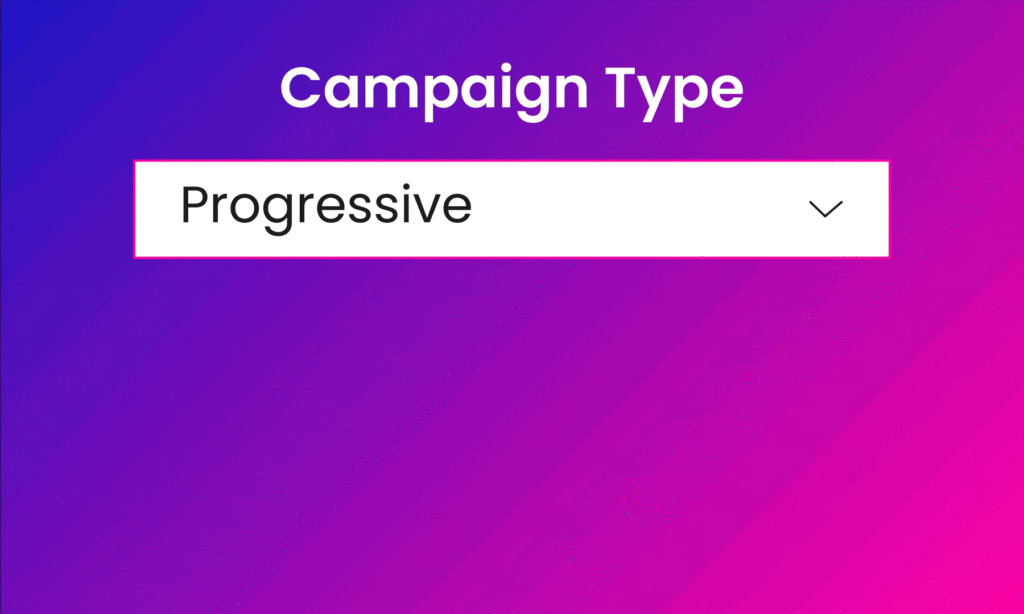
Contact Prioritisation
CCaaS software can also identify the most important calls and put them at the top of an agent’s list, using custom data fetching on your leads. This helps you connect more quality calls with customers or prospects who are less likely to hang up.
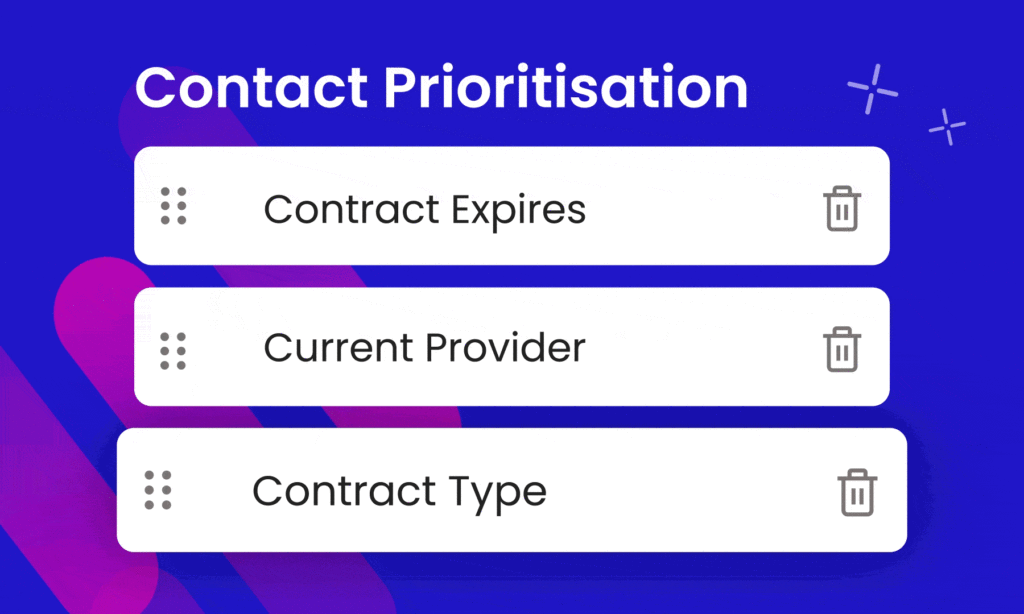
Outbound Skills-Based Routing
This clever functionality supercharges your campaign results by intuitively matching customers with their ideal agents.
Outbound skills-based routing is a relatively new technology that works across progressive, predictive and preview campaigns to connect customers with agents who have the relevant skills to handle the call. Live-call data is used to assign skill ratings to agents.
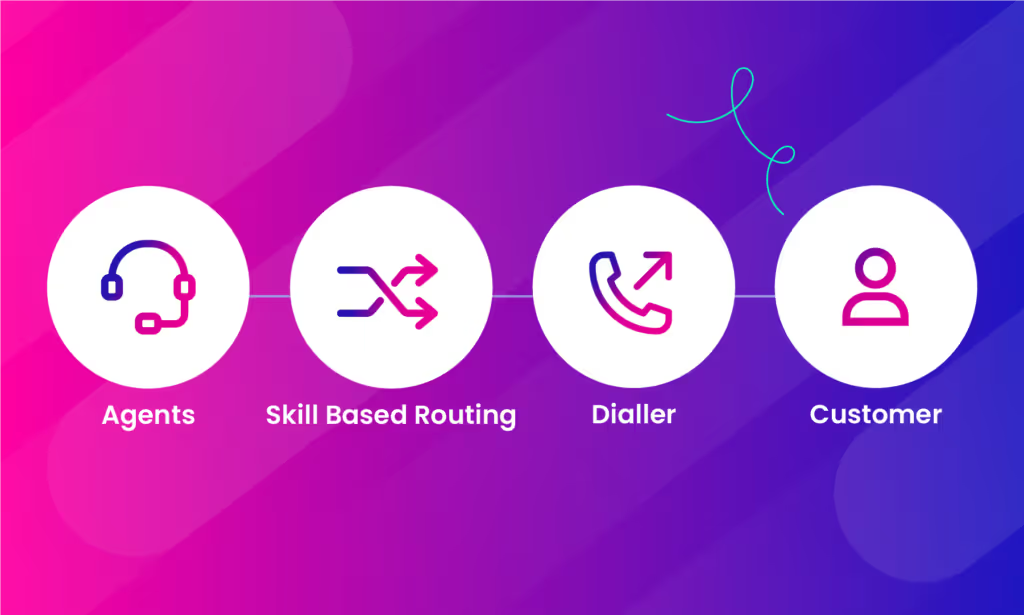
Challenge #2: Inefficient Agent Performance
While performance is on some level, determined by the individual agent, there are still plenty of things you can do to increase efficiency and motivation.
Problems
- High call volume and workload: When there is a high call volume to keep up with, agents can experience stress and burnout, leading to a significant drop in performance.
- Lack of proper training: Some call centres lack the resources to provide personalised agent training, meaning they don’t have the necessary skills and knowledge to handle a variety of call types and objections effectively.
- Inadequate scripting and resources: Poorly designed scripts or a lack of training and support resources are guaranteed to reduce productivity and ultimately, results.
Solutions
Automated Scripting and CRM Integration
An excellent feature of MaxContact CCaaS is the built-in scripting tools, which help agents handle calls efficiently and consistently with confidence in their script.
Meanwhile, integration with your existing CRM software helps agents easily personalise calls, with all the relevant information at their fingertips.
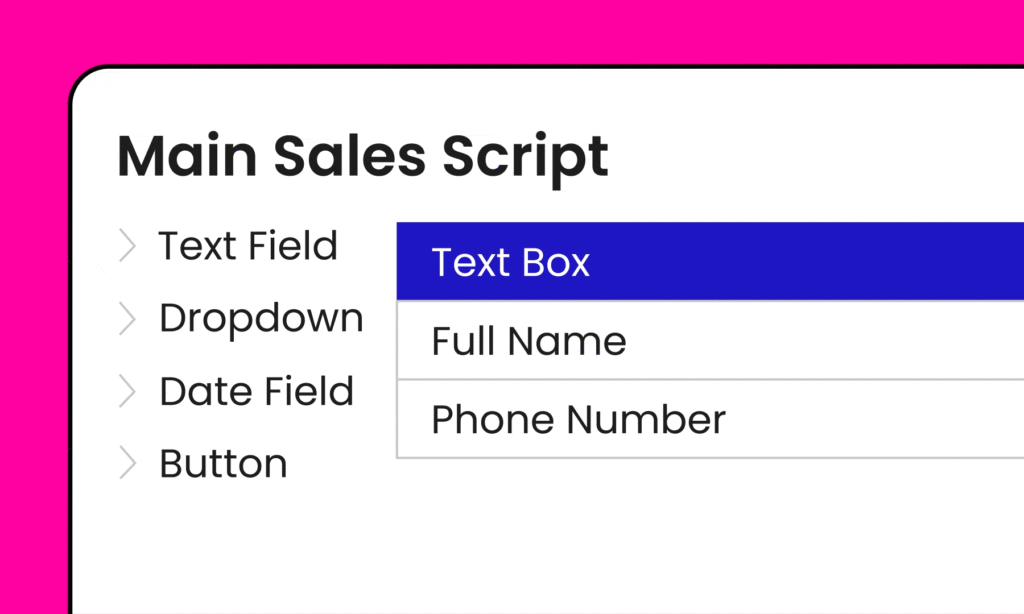
Call Recording and Data Insights
Using a CCaaS platform to record calls helps supervisors easily identify areas for improvement and provide tailored training to agents, boosting their skills and effectiveness.
Data Dashboards and Performance Management
Most modern CCaaS platforms feature data and performance dashboards which can encourage a more engaging work environment and introduce a dose of healthy competition. They use gamification elements to boost motivation and track progress.
Challenge #3: Difficulty Measuring Success
Collecting information about what works and what doesn’t is one of the only ways to tailor your approach to your unique customer base and operations, improving success exponentially. But collecting and organising that information can be a headache waiting to happen, and is often deprioritised as a result.
Problems
- Multiple success metrics: Many campaigns have more than one goal, and monitoring conversion rates, appointment bookings, or survey responses simultaneously can be challenging.
- Attribution challenges: It can be difficult to attribute specific outcomes to outbound calls as a range of other marketing efforts and customer touchpoints can also play a role.
- Lack of data-driven insights: Without comprehensive, readily available data, it’s difficult to make decisions to optimise call centre performance.
Solutions
Automated Analytics
Using CCaaS software that has automated analytics built-in is a simple way to optimise your campaign strategies. MaxContact provides custom solutions with the capacity to collect and present automated data insights from a range of performance metrics such as call volume, agent utilisation, and call duration.
Multi-Channel Reporting
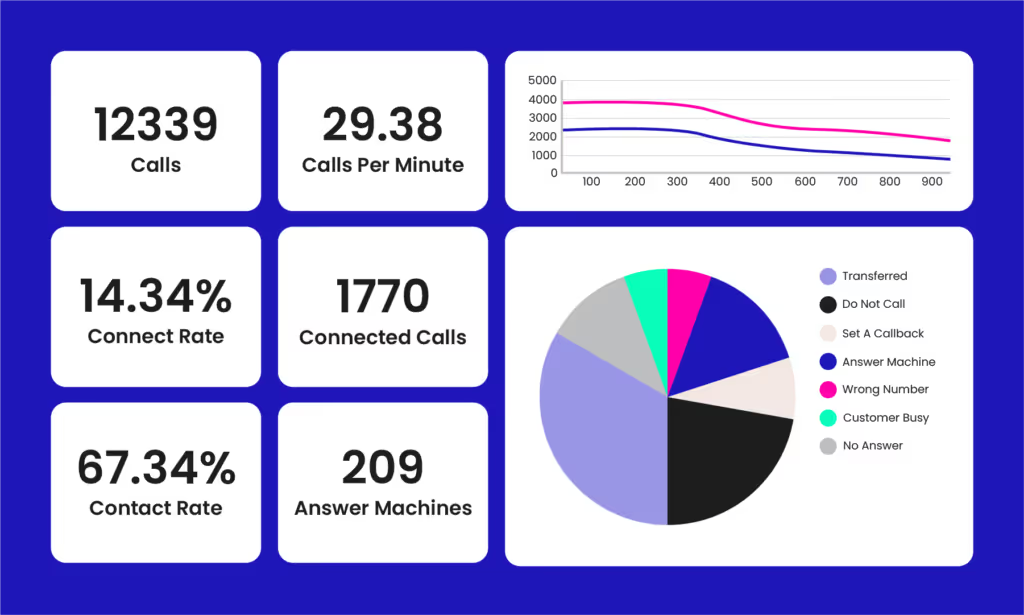
Taking it one step further, CCaaS can also facilitate data analysis across a range of different communication channels when integrated with your existing software. This provides a holistic view of customer interactions across all touchpoints, helping you gain a broader view of campaign performance.
Challenge #4: Compliance and Security
Breaches of compliance or security can be incredibly costly to an outbound call centre operation. But staying on top of ever-changing regulations can be just as pricey and time-consuming, without one streamlined solution.
Problems
- Complying with Do Not Call (DNC) lists: Dialling someone on the DNC list can result in hefty fines and penalties if you’re not careful.
- Taking payments quickly and securely: If your outbound call centre deals with payments, calls can be vulnerable to security breaches, damaging your reputation and leading to a significant loss of revenue.
Solutions
Built-in Regulatory Compliance
Having a CCaaS platform with built-in regulatory features is one way to avoid the compliance nightmare altogether.
MaxContact software features innovative DNC list scrubbing to automatically remove all names and contact information that appears on the registry from your database, reducing the likelihood of a fine. It also keeps your system up-to-date with call recording compliance and allows you to locate, edit or remove someone’s information on one simple page.
Secure Payment Handling
Take payments quickly and securely with PCI-DSS (Payment Card Industry Data Security Standard). The MaxContact CCaaS system allows agents to handle payments without viewing or hearing the specific card information of the customer. Instead, they can securely input their details using their keypad.
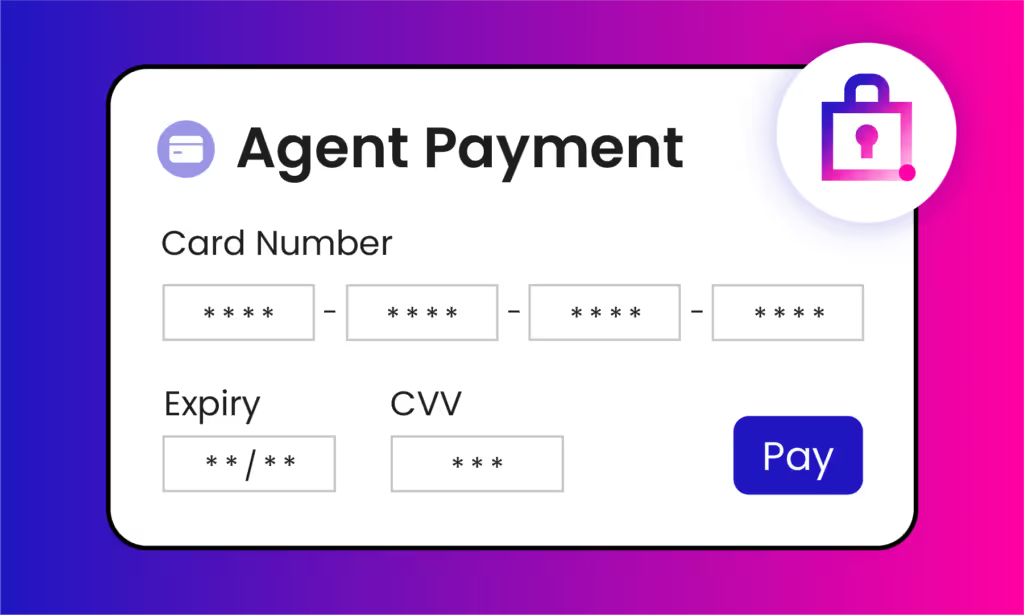
Data Encryption
Implementing robust security features into your CCaaS system is the best way to proactively protect against a potential breach. Depending on your operational needs, you can add a range of special features such as data encryption, access controls, and regular audits to safeguard sensitive customer information.
Additional Challenges Facing BPO Outbound Call Centres
Outbound call centre outsourcing is incredibly common, but BPOs often face more challenges than those that operate in-house. These include:
- Data Security and Privacy: BPOs that deal with sensitive customer data may face heightened concerns about privacy and compliance. This means they often require even more robust security measures and special technology to stay compliant with data protection regulations.
- Geographical limitations: Outbound call centre outsourcing puts distance between the business and its end customer, which sometimes makes it difficult to maintain performance and service quality. Auto quality assurance (QA) can assist in providing continued support to an outsourced team and connect the dots between the client and their customers.
Running an Effective Outbound Call Centre: Final Thoughts
While not without its challenges, running an effective call centre can be a lot easier with the right tools, technology and knowledge on your side.
MaxContact has transformed outbound operations for clients across a number of industries, from insurance comparison platforms to leading debt collection agencies.
Get in touch today to start running your outbound contact centre more efficiently, or download our guide for more information.

FPE Capital have helped finance an acquisition of MaxContact
We are pleased to announce FPE Capital have helped finance an acquisition of MaxContact led by the MaxContact management team.
Lars Pedersen, a serial SaaS executive, has joined the board as Non-Executive Chairman.
The acquisition will further help realise the management teams vision for the company and solution. With an investment of over £1.25m in additional staff already taken place, clients can expect an accelerated roadmap, more comprehensive product offering and uplift in service delivery. MaxContact will continue to innovate and enhance the solutions to all clients, along with an additional focus on other key areas such as security, compliance, stability and scalability of the solution.
David Barbour, Managing Partner at FPE, commented:
“FPE is delighted to have completed the growth investment into MaxContact. Our expertise is focussed on investing in companies operating in large markets that are experiencing change, where we can help the management team to accelerate their growth rate. The case for brands to improve their customers’ experience and scale their own operations by moving to a cloud-native solution such as MaxContact’s is proven. We are delighted to be supporting Ben and the management team in capitalising on that trend in the coming years”.
Ben Booth, CEO of MaxContact, added:
“We are delighted to have chosen FPE as our partner. Their experience in technology, and SaaS in particular, is a real differentiator and we are pleased to have them on board as we accelerate our product roadmap and invest in our go-to-market capabilities”.
MaxContact is customer engagement software that drives impact, conversions, and smarter customer experiences. Find out more about us.